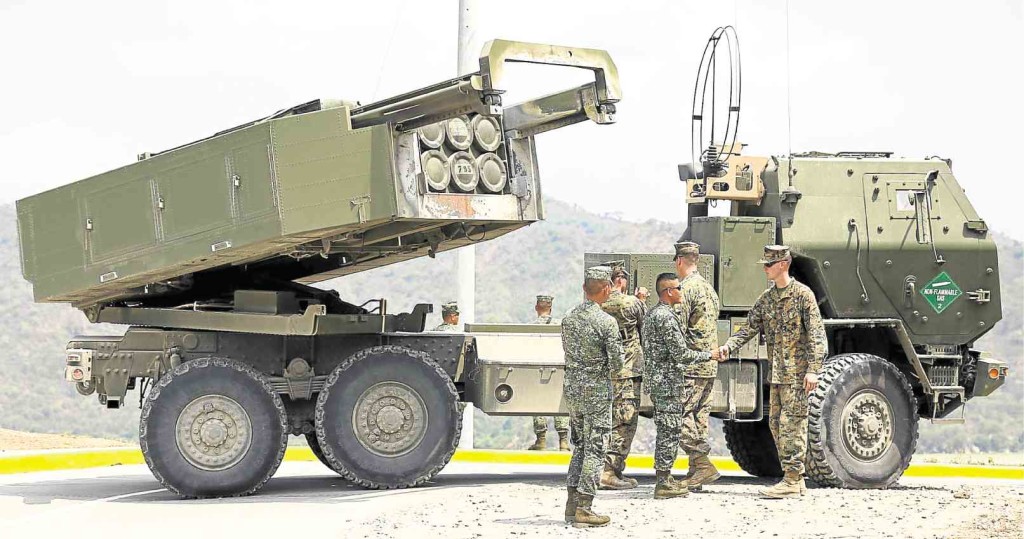US fires long-range missiles in Balikatan war games

LONG-RANGE MISSILE SYSTEM Filipino and US soldiers stand in front of a US military M142 High Mobility Artillery Rocket System (Himars) launcher during the live fire exercise of Balikatan 2016 in Capas, Tarlac, on Thursday. Lyn rillon
CAPAS, Tarlac—Glowing projectiles lit up the Philippine sky from an advanced US long-range missile system on Thursday, in war games aimed at boosting their military alliance in the face of an increasingly assertive China.
The High Mobility Artillery Rocket System (Himars) was the star of a simulated assault exercise by 5,500 US and Philippine soldiers, unleashing six missiles at distant targets from a dry riverbed three hours’ drive from Manila.
US Marine Cobra attack helicopters and Philippine S211 jets also buzzed over the Crow Valley training range as Filipino and US troops acted out the capture of imaginary enemy-held territory.
The exercises, called Balikatan (shoulder to shoulder) 2016, were staged in the shadow of a festering dispute between the poorly equipped US ally and regional giant China over islands, reefs and waters in the resource-rich South China Sea.
“The truth of the matter is we are allies and as allies, we need to work together,” Lt. Gen. John Toolan, the US Marine Corps Pacific commander and war games director for the US side, said when asked by reporters if the United States had plans of lending the missile system to the Philippines in case of armed conflict over the South China Sea.
“I think we will be more than happy to share,” he said.
The system’s range is 3,000 kilometers, Toolan said, meaning it could hit vessels far from the Philippine landmass.
It costs around $5 million.
China claims most of the South China Sea, even waters and rocks close to the coasts of several neighbors that overlap with their claims.
Beijing has reclaimed several reefs claimed by Manila and built structures on them that the Philippines alleges were designed for military use, a charge China denies.
‘Highly mobile, lethal’
Although the United States has not taken a stand on the conflicting claims to the South China Sea, it has opposed China’s efforts to claim the waters and has stressed freedom of navigation in the vital sea-lane.
“We have seen the capability. It is highly mobile, lethal. So I think it is one of the capabilities we want to have,” Philippine Navy Vice Adm. Alexander Lopez, war games director for the Philippines, said as he watched the missile firing.
He said the missile system, being highly mobile, could be deployed anywhere in the Philippines.
Defense Secretary Voltaire Gazmin was also impressed by the performance of the missile system, he added.
Lopez, the commander of Filipino forces in the South China Sea, told reporters this would “raise the skill and the respect for your armed forces, not only for the Filipinos but also in our region.”
Toolan said the two-week maneuvers displayed the capability of both armies to deploy rapidly across the Philippines.
The truck-mounted missile system had been flown aboard a giant military transport plane to an airport near the Crow Valley firing range earlier in the day from the western Philippine
island of Palawan.
Toolan said the US military planned to test the missile system aboard a sea vessel.
“We are going to test it off the deck of a ship. So when it reaches 300 km, it’s a pretty good distance,” he said.
The Philippines has been improving its defense ties with the United States to help upgrade its capability to defend its territory.
READ: US reveals joint patrols in South China Sea with PH
5 PH bases
The Philippines has allowed American forces to rotate through five Philippine bases, including one on Palawan and another in the north, both close to the South China Sea, under the Enhanced Defense Cooperation Agreement, or Edca.
Asked if Himars systems would be deployed in these five bases, Toolan said: “That’s not necessarily in the plan but obviously, with the mobility the Himars gives you, you can use it anywhere.” Reports from AFP and Julie M. Aurelio
RELATED VIDEO


RELATED STORIES
For comprehensive coverage, in-depth analysis, visit our special page for West Philippine Sea updates. Stay informed with articles, videos, and expert opinions.